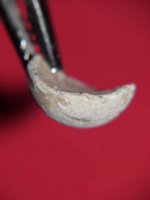By the time of the American civil war, the use of an internal "powdercan" had been found to be unnecessary for Field Artillery calibers of cannonballs (6-, 12-, and 24-pounder). That is also true for most types of Rifled cannon Case-Shot projectiles. Take a close look at photos of sawed-in-half Case-Shot projectiles and you'll see that only two types used a powdercan ...they are Parrott (all calibers) and 4.5" Dyer Case-Shot.
Jusmct asked:
> I'm new to the forum and would like to find out how a 12lb US Bormann shell was assembled.
Your guess is pretty close.
1- The empty cavity in the "Case" (body) was filled full of lead balls or slugs.
2- The matrix material (such as pitch, sulfur, or asphalt) was heated in a large pot until it became molten/liquid.
3- The molten matrix material was then poured down the projectile's fuzehole until the cavity was entirely filled.
4- The molten matrix was allowed to cool until it completely solidified.
5- A LARGE (5/8-to-7/8") auger drillbit was then used to create a cavity for the bursting-charge powder, by simply drilling down through the solidified matrix and lead balls. (See footnote #1.)
6- The prescribed amount (weight) of powder was then inserted. (See footnote #2.)
7- Screw in the Bormann fuze's brass or iron support-plug (also called an underplug).
8- The Bormann fuze itself was generally NOT inserted into the shell at the shell-manufacturing factory. It was inserted when the shells were issued to the ammo-supply wagons "in the field."
Footnote #1:
Diggers and collectors often encounter proof that the Case-Shot's powder cavity was made by simply drilling a hole down through the balls & matrix. You'll find some lead case-shot balls which got "nicked" by the big auger drillbit ...it cut a wide "gutter-shaped" channel into the edge of the lead ball.
Footnote #2:
The prescribed amount of powder for the bursting-charge in a 12-pounder Case-Shot was one ounce. (For 12-pounder Common-Shells, it was 6 ounces of powder ...but was changed to 7 ounces late in the war.)
Regards,
Pete [P.C. George]


